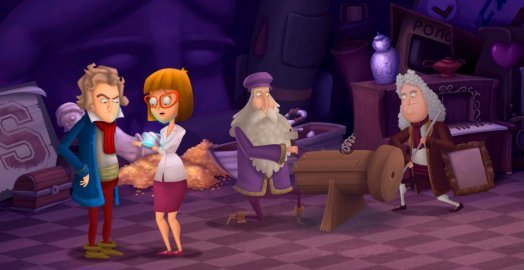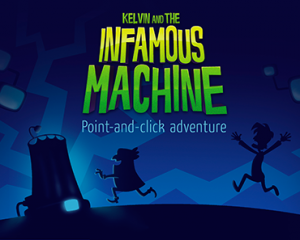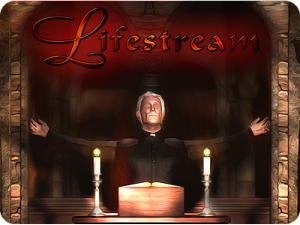Review for Kelvin and the Infamous Machine

Time travel allows for an abundance of absurd scenarios, multi-layered gameplay and inventive narrative possibilities, so it’s no wonder that adventure game developers like Blyts find it a fascinating premise. Kelvin and the Infamous Machine may not be Day of the Tentacle, but it’s clearly been influenced by the LucasArts classic, harkening back to the golden age of point-and-clicks while changing up the formula and adding enough pop culture references to sink the Titanic. It’s not the longest of rides, but it’s a humorous and fun romp through a mangled history, if not without its minor flaws.
The story, as explained in the first two minutes via cutscene, is that Kelvin and Lise are lab assistants to the eccentric Dr. Lupin, who has created a time machine in the guise of a shower. When said shower/time machine is derided by the scientific community for being… well, stupid-looking, Lupin goes a little crazy and attempts to change the past so that all of history’s greatest achievements will be attributed to him, rather than to their rightful inventors, discoverers and artists. Aside from the fact that this is a crime against history, it also threatens to unravel the very fabric of the time-space continuum. And so, aided by Lise on video-com from the science lab, Kelvin is thrust into the past and tasked with fixing what Lupin has broken, before the world collapses in on itself. Specifically, Kelvin must aid Beethoven, Isaac Newton and Leonardo Da Vinci.
Each of these “worlds” is a veritable anachronism stew, with playful shout-outs to anything and everything in nerdy pop culture, from Harry Potter and Lord of the Rings to a cute cutscene where Kelvin’s shower is swapped out for the eleventh Doctor’s TARDIS. Of course, this is to be expected in a time travel game, as many things can be explained by Lupin’s messing with the time stream and sending things where they’re not supposed to go. Unfortunately, even though the writing is good, the multitude of pop culture references take precedence over original humor.
The game is split into four chapters, with a progress bar on the main menu showing how far along in a specific chapter you are at any point, which I found extremely useful. You click where you want Kelvin to walk, and on objects for closer examination or to pick them up. There is a hotspot highlighter you can use, though it’s not necessary as it’s fairly obvious what can and cannot be interacted with. Kelvin’s backpack stays in the top right corner the entire time, and clicking on it opens it up and allows you to use the objects inside, both with each other and directly within your surroundings. However, the inventory is emptied at the end of each chapter so you can’t take objects to different time periods with you.
The characters are a fun bunch, if not particularly memorable. Kelvin is the everyman, an idiot hero who in no way should be trusted to operate a toaster, let alone a time machine. However, he’s the world’s only hope so he’ll have to do. Full of quirky comebacks and sardonic explanations, Kelvin manages to stay both upbeat and distracted through the entire adventure and is the key factor in maintaining the game’s silly atmosphere. His partner in saving the universe, Lise, is the archetypal boring, by-the-rules girl who has no time for nonsense and stays focused on the mission. While she is in the lab the whole time and not actually in the field with Kelvin, she pops up a few times per chapter on Kelvin’s communicator watch to try to keep him on track with his objectives.
Despite being the game’s villain, Dr. Lupin is a very flimsy character as there is no interaction with him until the last chapter, so he just comes across as being nuttier than a Snickers bar. The three geniuses of the past, however, are quite funny. Beethoven is already deaf and ends up shouting everything at you, though he’s not terribly responsive, for obvious reasons. Isaac Newton is obsessed with Larry Plotter fanfiction, which seems to be a cross between Harry Potter and Twilight, at 27 books long. Leonardo, meanwhile, is actually a very ingenious Sherlock Holmes type of character, and I thoroughly enjoyed his chapter because of it. The supporting characters don’t have a lot of backstory, but they’re funny and quick with the one-liners, as is their purpose. Special mention goes to the character credited as “Robin Hood?” in Isaac Newton’s chapter. He’s drunk as a skunk the entire time, quite possibly the world’s worst shot and delusional, but highly entertaining.
In each time period you need to ensure that its respective genius completes one of their masterworks. For example, Beethoven needs assistance completing his fifth symphony after Lupin’s interference, so Kelvin has to get creative. Newton, in turn, needs to write his theories of relativity rather than more fanfic for his favorite series. And Da Vinci must paint the Mona Lisa, with the slight hitch that Lisa quit so he has to use her sister Mona, who isn’t quite as photogenic, forcing Kelvin to improvise ways to change her appearance.
With each era being self-contained, the puzzles tend to fall on the easy side. The hardest (and also longest) chapter is definitely the third, but the game does a good job of warming up the challenge in the first two time periods and making the obstacles progressively more difficult. The puzzles are almost entirely inventory/environmental-based, with only one other that requires memorizing a pattern. The first two levels don’t have an overabundance of items to collect and use, which helps keep the solutions simple. However, there is quite a large jump in difficulty between Newton’s second level and Da Vinci’s third, partly due to the greatly expanded environment and partly because there are far more items to acquire.
Unfortunately, Kelvin has no hint system, which was frustrating at times as there aren’t always enough clues or a logical puzzle progression. However, I managed to make my way through most of the game unaided, and it wasn’t until one point in Leonardo’s harder third chapter that I finally conceded to looking up a puzzle solution. That’s not to say the game provides no challenge throughout—the puzzles are by no means easy, but they are workable without falling into an endless pit of despair. Even without a hint system, eventually through trial-and-error you can find the answer that's been eluding you.
The gameplay is accompanied by an original soundtrack with different themes for each era and occasionally even distinct locations. My personal favorite is the tune that plays in the third chapter’s graveyard, as it’s spooky without actually implying any real danger; it’s classic and catchy. Most of the background music has a very Renaissance Faire vibe to it, with traditional-sounding instruments such as violin, pianos, flutes and pipes all coming to mind. It isn’t a standout score, but it completes the atmosphere very nicely. Particular acknowledgement goes to the song title “A Vomiting Geyser of Dragonfire” on the soundtrack listing for being a hilarious indicator of the game’s tone. The voice acting is also well done, my favorite being Kelvin’s performance.
The game has a simple 2D art style that uses shading on both characters and backgrounds to prevent them from looking flat. All of the characters are stylized and rather look like they’ve come out of a ‘90s kids cartoon, with thin arms and legs and peculiarly shaped heads. Just about the only one who resembles normal is Lisa’s sister Mona, for obvious reasons. The backgrounds are the same way, slightly deformed but fitting in perfectly with the characters and overall feel of the game. A boatload of anachronisms doesn’t overwhelm the actual period settings, but it nicely reinforces the fact that something peculiar is definitely going on. For example, outside of a library in 18th century England is an automatic drink cart, and Newton’s garden (which you get thrown out of) is adorned with a plastic lawn flamingo. It's a shame that most of the game is quite static, as there is a lack of background animation and characters have fairly short, basic animation loops.
Clocking in between 6-8 hours, Kelvin and the Infamous Machine isn’t a huge time sink, but it’s a great breather in between some tougher and/or darker adventure games, thanks to its amusing writing, fun characters, a wacky plot, and puzzles with a gentle learning curve that never get too frustratingly difficult. It’s also a pretty good entry point for anyone new to the adventure genre, though the lack of a hint system isn’t nearly as user-friendly. The overreliance on pop culture references, as well as the lack of any real character depth keeps it from reaching its full potential, but overall this is a very solid game from a first-time developer, and a welcome throwback to the classic adventuring days of old.



























